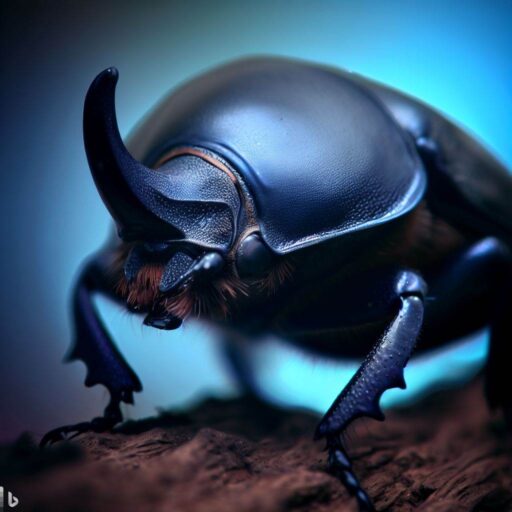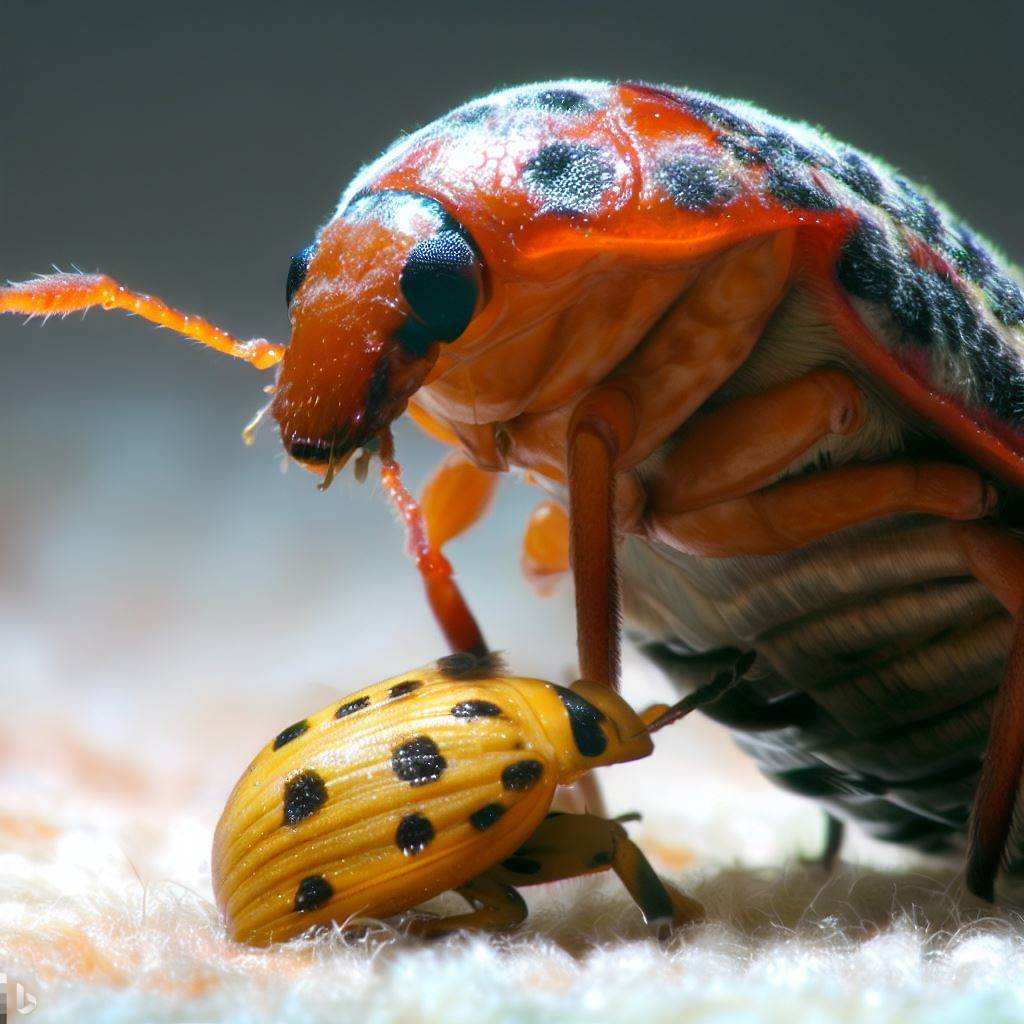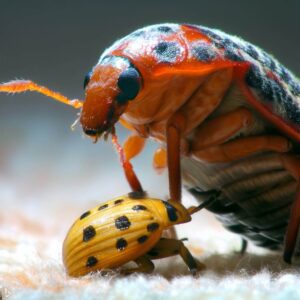Key Takeaways:
- Carpet beetles and bed bugs are two common pests that can infest homes, but they have significant differences in their behavior, appearance, and the signs of infestation they leave behind.
- Physically, carpet beetles are small, oval-shaped insects with colorful scales on their bodies, while bed bugs are flat and reddish-brown.
- Identifying the signs of infestation is crucial in distinguishing between carpet beetles and bed bugs. Carpet beetles are attracted to natural fibers like wool and leave behind irregularly shaped holes in fabrics, while bed bugs leave behind small blood stains and bite marks on the skin.
Introduction: Carpet Beetle vs Bed Bug
Carpet Beetle vs Bed Bug: Comparing these common household pests reveals key distinctions.
While carpet beetles are primarily attracted to natural fibers and can cause damage to carpets, clothes, and furniture, bed bugs feed on human blood and infest mattresses and furniture.
Understanding their differences is crucial in effective pest management.
Furthermore, carpet beetles can often be found outdoors and are attracted to sunlight, whereas bed bugs thrive in indoor environments and prefer darkness.
To effectively differentiate between the two pests, it is essential to identify specific characteristics.
Carpet beetles have distinctive oval-shaped bodies covered in scales or varied patterns while bed bugs are reddish-brown and have a flat, oval-shaped body.
When dealing with an infestation, it is crucial to take immediate action.
Contact a professional pest control service to eradicate the pests and prevent further damage to your home.
Neglecting the situation may lead to increased infestation, potential health risks, and unnecessary costs.
Act promptly to ensure a pest-free environment.
The Differences Between Carpet Beetles and Bed Bugs
Carpet beetles and bed bugs differ in several aspects. Here are some key differences:
- Appearance: Carpet beetles have rounded bodies covered in scales and are typically black, white, or a combination of both. Bed bugs are flat and oval-shaped, with a reddish-brown color.
- Diet: Carpet beetles feed on natural materials like wool, fur, and feathers, while bed bugs feed on human blood.
- Behavior: Carpet beetles are attracted to light and can fly, while bed bugs are nocturnal and prefer dark hiding places.
- Bite marks: Carpet beetles do not bite humans and leave no visible bite marks. Bed bug bites cause itchy, red welts on the skin.
- Infestation signs: Carpet beetle infestations are indicated by damage to fabrics and the presence of shed skins and fecal pellets. Bed bug infestations are detected through the presence of live bugs, blood stains on bedding, and dark spots of excrement.
- Treatment: Carpet beetles can be controlled by thorough cleaning and removing infested items. Bed bugs, on the other hand, require professional pest control treatments.
While these differences are essential in distinguishing the two pests, it is crucial to act promptly upon suspecting an infestation to prevent further complications.
A friend of mine recently discovered a severe bed bug infestation in their apartment.
Despite mistaking the initial signs for carpet beetle activity, they soon realized the presence of bed bugs after experiencing multiple bites.
The situation escalated quickly, and they had to seek professional help to eradicate the infestation.
This incident highlights the importance of correctly identifying and addressing pest problems to avoid unnecessary distress and damages.
Physical Characteristics Comparison
Carpet beetles and bed bugs can be differentiated based on their physical characteristics.
In terms of size, carpet beetles are usually smaller, measuring around 1/8 inch to 3/16 inch in length.

On the other hand, bed bugs are slightly larger, ranging from 1/4 inch to 3/8 inch in length.

The color of carpet beetles varies, and they can be found in shades of black, white, and brown.
Some species also have patterns or spots on their wings.
Bed bugs, however, are typically reddish-brown, becoming darker after feeding on blood.
When it comes to body shape, carpet beetles have an elongated oval shape.
They have a hard exoskeleton and are covered in tiny hairs.
Bed bugs, on the other hand, have a more flattened and oval-shaped body.
They also have a distinctive segmented appearance.
Carpet Beetle vs Bed Bug Bites
One of the most common ways to identify an infestation is by examining the bites left behind by carpet beetles and bed bugs.
While both pests can cause skin irritations, there are distinct differences in the appearance and characteristics of their bites.
Understanding these variations can help you determine which pest you are dealing with and take appropriate measures to address the situation.
Carpet Beetle Bites:
Carpet beetles do not actually bite humans.
Instead, they have tiny hairs on their bodies that can cause allergic reactions in some individuals.
These hairs, often found on the larvae, shed as they move around your home.
When these hairs come into contact with your skin, they can cause redness, itching, and mild skin irritation.
However, these reactions are usually milder compared to the bites caused by bed bugs.
It’s important to note that carpet beetle bites are not as common as bed bug bites since carpet beetles primarily feed on natural fibers, such as wool, silk, and fur.
They are more likely to be found in areas where these materials are present, such as carpets, upholstered furniture, and stored clothing.
If you suspect carpet beetle infestation, it’s best to focus on identifying the beetles themselves or their shed skins rather than searching for bites.
Bed Bug Bites:
Bed bug bites, on the other hand, are known for their characteristic appearance and potential to cause discomfort.
These bites typically occur in clusters or a line pattern and are often accompanied by intense itching.
Bed bugs are attracted to body heat and carbon dioxide, making areas near sleeping or resting places their preferred feeding grounds.
The bites of bed bugs usually appear as small, red welts on the skin.
They can resemble mosquito bites or an allergic reaction, and some people may not even develop visible skin reactions to bed bug bites.
However, many individuals experience significant itching and irritation, which can lead to secondary skin infections if scratched excessively.
Bed bugs are opportunistic feeders and can be found in various environments, including homes, hotels, dormitories, and even public transportation.
If you suspect a bed bug infestation, it is essential to thoroughly inspect your bedding, furniture, and cracks in walls or floors to locate signs of these pests.
Seeking Professional Assistance:
If you are unsure whether the bites you are experiencing are caused by carpet beetles or bed bugs, it’s recommended to consult with a pest control professional.
They have the expertise to accurately identify the source of the infestation and provide appropriate treatment options.
Remember, it is crucial to address any pest infestation promptly to prevent further spread and potential health issues.
Whether it’s carpet beetles or bed bugs, taking swift action will help restore the comfort and well-being of your living environment.
Signs of Infestation: Identifying Carpet Beetles vs Bed Bugs
Carpet Beetles vs Bed Bugs: How to Identify Infestation Signs
Infestation signs can vary between carpet beetles and bed bugs. To accurately identify these pests, consider the following points:
- Appearance: Carpet beetles are small, oval-shaped insects with colorful scales, while bed bugs are flat, reddish-brown parasites that resemble apple seeds.
- Damage Patterns: Carpet beetles may chew on fabrics, leaving irregular holes or bare patches. Bed bugs, on the other hand, leave behind red, itchy bite marks on the skin.
- Preferred Habitats: Carpet beetles tend to infest areas with natural fibers such as carpets, upholstery, and clothing. Bed bugs commonly hide in the seams and crevices of mattresses, furniture, and walls.
- Activity Period: Carpet beetles are active during the day and are often attracted to natural light sources. Bed bugs are nocturnal creatures, feeding on humans while they sleep.
- Fecal Traces: Carpet beetle larvae produce pellet-shaped fecal matter, which may be visible near infested materials. Bed bugs leave behind small black stains or dark brown spots on bedding or furniture.
- Unique Tell-Tale Signs: Carpet beetles may shed their skin, leaving behind empty exoskeletons. Meanwhile, bed bugs emit a distinct musty odor, particularly when infestations are severe.
It’s essential to note that these details highlight the differences in signs of infestation between carpet beetles and bed bugs.
Being aware of these nuances can help in promptly addressing any pest issues.
Pro Tip: If you suspect an infestation, it is prudent to consult a professional pest control service for accurate identification and efficient elimination of the pests.
How Carpet Beetles and Bed Bugs Travel and Infest
Carpet beetles and bed bugs have different methods of travel and infestation.
Understanding these variations is crucial to effectively deal with an infestation. Here’s a breakdown of how these pests travel and infest:
| Carpet Beetles | Bed Bugs | |
|---|---|---|
| Travel Abilities | Adult beetles can fly, while larvae crawl and hitchhike on items like clothing and furniture. | Adult bed bugs crawl but cannot fly or jump. They are adept at hitchhiking on luggage, clothing, and furniture. |
| Infestation Signs | Damage to natural fibers, such as carpets, clothing, and upholstery. Larvae shed skin and fecal pellets. | Stains or spots of blood on sheets, dark spots of excrement on mattresses, and the presence of live bugs. |
| Preferred Habitat | Carpet beetles infest natural materials like wool, fur, and silk. They may also infest stored food products. | Bed bugs prefer warm environments and are commonly found in mattresses, box springs, and bedding. They can also hide in cracks and crevices in furniture and walls. |
In addition to this information, it is important to note that both carpet beetles and bed bugs can quickly and easily spread within a home or property if not properly addressed.
It is crucial to seek professional pest control services to eradicate these pests and prevent further infestation.
As for the historical context related to this topic, carpet beetles have been a nuisance to households for centuries.
Their destructive feeding habits on various natural materials have caused significant damage throughout history.
Similarly, bed bugs have plagued humans for thousands of years, with infestations documented as far back as ancient Egypt.
Understanding their travel and infestation patterns can help us better combat these pests and protect our homes.
What to Do If You Suspect Bed Bugs
If you suspect the presence of bed bugs, take immediate action to prevent infestation. Follow this 4-step guide to address the issue effectively:

- Inspection: Thoroughly examine your mattress, furniture, and other areas where bed bugs may hide. Look for signs of live bugs, such as reddish-brown stains, dark spots, and shed skins.
- Containment: If you find any evidence of bed bugs, isolate the infested items by sealing them in plastic bags or covers. This helps prevent the bugs from spreading to other areas of your home.
- Consultation: Contact a professional pest control company specialized in bed bug extermination. They have the expertise and effective treatment methods to eliminate the infestation and prevent future occurrences.
- Prevention: Take proactive measures to prevent bed bugs from returning. Regularly vacuum your home, wash bedding at high temperatures, and avoid bringing used furniture or belongings of unknown origin into your home.
Remember, acting promptly is crucial in addressing a bed bug problem.
Ignoring or procrastinating can lead to a more significant infestation, making it harder to eradicate these pests.
Pro Tip: When traveling, inspect hotel rooms thoroughly before unpacking. Check the mattress seams, headboard, and nearby furniture for any signs of bed bugs.
Conclusion: Addressing Bed Bug and Carpet Beetle Infestations
Addressing Bed Bug and Carpet Beetle Infestations: A Comprehensive Approach
When dealing with infestations of bed bugs and carpet beetles, it is crucial to adopt a thorough and systematic strategy.
By understanding the characteristics, behaviors, and preferred habitats of both pests, homeowners can effectively address these issues.
Prevention, identification, and treatment methods specific to each type of infestation should be implemented promptly to ensure successful eradication.
To effectively address bed bug and carpet beetle infestations, proactive prevention measures are paramount.
Regularly inspecting and cleaning the living environment, including bedding, furniture, and carpets, can help identify the presence of these pests before an infestation occurs.
Additionally, implementing proper storage techniques for clothing and fabrics can minimize the risk of carpet beetles.
In terms of identification, it is important to discern between bed bugs and carpet beetles accurately.
While both pests can cause skin irritations, bed bugs solely feed on blood and are often found near sleeping areas, whereas carpet beetles feed on household items like fabrics, upholstery, and stored food.
Understanding these distinctions is crucial in implementing the appropriate treatment methods.
When it comes to treatment, there are specific approaches for each infestation.
Professional pest control services may be necessary for severe infestations, as they have the expertise and experience to effectively eliminate both bed bugs and carpet beetles.
Additionally, targeted treatments such as steam cleaning for bed bugs and insecticide application for carpet beetles can be applied.
Regular monitoring and follow-up treatments are essential to ensure complete eradication.
Given the damaging and irritating consequences of bed bug and carpet beetle infestations, addressing them promptly is crucial.
Ignoring the issue may lead to severe consequences, such as property damage or health implications.
By taking proactive measures, seeking professional assistance, and implementing appropriate treatments, homeowners can effectively address these infestations and safeguard their living environment.
Protect your home and well-being by addressing bed bug and carpet beetle infestations promptly and comprehensively.
Five Facts About Carpet Beetle vs Bed Bug:
- ✅ The most significant difference between carpet beetles and bed bugs is that carpet beetles don’t bite, while bed bugs do.
- ✅ Bed bugs need blood to grow and reproduce, while carpet beetle larvae eat organic matter such as wool, fabric, carpet, leather, and feathers.
- ✅ Bed bugs are small, oval-shaped, and reddish brown or tan, while carpet beetles are oval shaped and can be black, brown, white, or orange with a molted pattern.
- ✅ Signs of carpet beetles include beetles flying or climbing walls, damaged carpet, upholstery, clothing, and larvae skin sheds, while signs of bed bugs include bites, blood stains on sheets or pillowcases, and egg casings.
- ✅ Both carpet beetles and bed bugs can be transported through luggage, furniture, or clothing, but bed bugs are notorious for hitchhiking during travel.
FAQ
What are the differences between bed bugs and carpet beetles?
The most significant difference between bed bugs and carpet beetles is that bed bugs bite, while carpet beetles do not.
Bed bugs need blood to grow and reproduce, while carpet beetle larvae feed on organic matter such as wool, fabric, carpet, leather, and feathers.
Additionally, bed bugs are small, oval-shaped, reddish brown or tan, and do not have wings, while carpet beetles are oval-shaped, and can be black, brown, white, or orange with a molted pattern and wings.
The New York City Health Department has a PDF, “Is it a Bed Bug, Cockroach or Carpet Beetle?” that you can download and look at.
Do carpet beetles bite like bed bugs?
No, carpet beetles do not bite like bed bugs.
While some people may experience an allergic reaction to the hair on carpet beetle larvae’s body, it does not cause actual bites.
Carpet beetle larvae are covered in prickly hair bristles that can cause a reaction in humans who are allergic, but it is not the same as a bed bug bite.
What are the signs of a carpet beetle infestation?
Signs of a carpet beetle infestation may include beetles flying or climbing walls, damaged carpet, upholstery, or clothing, hairs falling out of trophy animals, larvae and larvae skin sheds, and dead beetles in windowsills.
What are the signs of a bed bug infestation?
Signs of a bed bug infestation may include bites, blood stains on sheets or pillowcases, rust-colored stains on beds and furniture, egg casings, skin sheds, and a musty odor.
How do carpet beetles and bed bugs spread?
Both carpet beetles and bed bugs are hitchhikers that can spread by latching onto clothes, luggage, or furniture. Bed bugs often spread through travelers, crawling into suitcases or purses and spreading through airports and hotels.
On the other hand, carpet beetles may hitchhike or fly in through open windows or doors to deposit eggs in various locations.
What are the treatment options for bed bugs?
Treatment options for bed bugs include conventional treatment, which involves steam treatment, HEPA vacuuming, and pesticide injection for cracks and crevices.
Thermal treatment is a non-chemical green option that uses forced air heaters to raise the temperature and “bake” the bed bugs.
Offsite fumigation is another option where contaminated items are taken to an offsite facility for treatment.
The specific method of remediation would be recommended by a pest control professional based on the size and nature of the infestation.






Leave a Reply